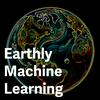44 episodios

Differentiable and accelerated spherical harmonic and Wigner transforms
19/12/2025 | 13 min
Differentiable and accelerated spherical harmonic and Wigner transformsMatthew A. Price, Jason D. McEwen*Journal of Computational Physics (2024)** This work introduces novel algorithmic structures for the **accelerated and differentiable computation** of generalized Fourier transforms on the sphere ($S^2$) and the rotation group ($SO(3)$), specifically spherical harmonic and Wigner transforms.* A key component is a **recursive algorithm for Wigner d-functions** designed to be stable to high harmonic degrees and extremely parallelizable, making the algorithms well-suited for high throughput computing on modern hardware accelerators such as GPUs.* The transforms support efficient computation of gradients, which is critical for machine learning and other differentiable programming tasks, achieved through a **hybrid automatic and manual differentiation approach** to avoid the memory overhead associated with full automatic differentiation.* Implemented in the open-source **S2FFT** software code (within the JAX differentiable programming framework), the algorithms support various sampling schemes, including equiangular samplings that admit exact spherical harmonic transforms.* Benchmarking results demonstrate **up to a 400-fold acceleration** compared to alternative C codes, and the transforms exhibit **very close to optimal linear scaling** when distributed over multiple GPUs, yielding an unprecedented effective linear time complexity (O(L)) given sufficient computational resources.

Score-based diffusion nowcasting of GOES imagery
11/12/2025 | 12 min
Score-based diffusion nowcasting of GOES imagery*Randy J. Chase, Katherine Haynes, Lander Ver Hoef, Imme Ebert-Uphoff, a Cooperative Institute for Research in the Atmosphere, Colorado State University, Fort Collins, CO, b Electrical and Computer Engineering, Colorado State University, Fort Collins, CO** The research explored score-based diffusion models to perform short-term forecasts (nowcasting) of GOES geostationary infrared satellite imagery (zero to three hours). This newer machine learning methodology combats the issue of **blurry forecasts** often produced by earlier neural network types, enabling the generation of clearer and more realistic-looking forecasts.* The **residual correction diffusion model (CorrDiff)** proved to be the best-performing model, quantitatively outperforming all other tested diffusion models, a traditional Mean Squared Error trained U-Net, and a persistence forecast by one to two kelvin on root mean squared error.* The diffusion models demonstrated sophisticated predictive capabilities, showing the ability to not only advect existing clouds but also to **generate and decay clouds**, including initiating convection, despite being initialized with only the past 20 minutes of satellite imagery.* A key benefit of the diffusion framework is the capacity for **out-of-the-box ensemble generation**, which enhances pixel-based metrics and provides useful uncertainty quantification where the spread of the ensemble generally correlates well to the forecast error.* However, the diffusion models are computationally intensive, with the Diff and CorrDiff models taking approximately five days to train on specialized hardware and about 10 minutes to generate a 10-member, three-hour forecast, compared to just 10 seconds for the baseline U-Net forecast.

FuXi-Ocean: A Global Ocean Forecasting System with Sub-Daily Resolution
04/12/2025 | 15 min
FuXi-Ocean: A Global Ocean Forecasting System with Sub-Daily Resolution*Qiusheng Huang, Yuan Niu, Xiaohui Zhong, Anboyu Guo, Lei Chen, Dianjun Zhang, Xuefeng Zhang, Hao Li*---* **First Data-Driven Sub-Daily Global Forecast:** FuXi-Ocean is the first deep learning-based global ocean forecasting model to achieve six-hour temporal resolution at an eddy-resolving 1/12° spatial resolution, with vertical coverage extending up to 1500 meters. This capability addresses a crucial need for high-frequency predictions that traditional numerical models struggle to deliver efficiently.* **Adaptive Temporal Modeling Innovation:** A key component of the model is the **Mixture-of-Time (MoT) module**, which adaptively integrates predictions from multiple temporal contexts based on variable-specific reliability. This mechanism is crucial for accommodating the diverse temporal dynamics of different ocean variables (e.g., fast-changing surface variables vs. slowly evolving deep-ocean processes) and effectively mitigates the accumulation of forecast errors in sequential prediction.* **Superior Performance and Efficiency:** The model demonstrates superior skill in predicting key variables (temperature, salinity, and currents) compared to state-of-the-art operational numerical forecasting systems (like HYCOM, BLK, and FOAM) at sub-daily intervals. Furthermore, it achieves this high performance with remarkable data efficiency, requiring only approximately 9 years of training data and relying solely on ocean variables (T, S, U, V, SSH) as input, without external data dependencies like atmospheric forcing.* **High-Impact Applications:** By providing accurate, high-resolution, sub-daily forecasts, FuXi-Ocean creates critical opportunities for maritime operations, including improved navigation, search and rescue, oil spill trajectory tracking, and enhanced marine resource management, particularly due to its comprehensive vertical coverage (0-1500 m).

Beyond the Training Data: Confidence-Guided Mixing of Parameterizations in a Hybrid AI-Climate Model
28/11/2025 | 15 min
Beyond the Training Data: Confidence-Guided Mixing of Parameterizations in a Hybrid AI-Climate Model*By Helge Heuer, Tom Beucler, Mierk Schwabe, Julien Savre, Manuel Schlund, and Veronika Eyring** This paper presents a **successful proof-of-concept for transferring a machine learning (ML) convection parameterization**—trained on the ClimSim dataset—to the ICON-A climate model. The resulting hybrid ML-physics model achieved stable and accurate simulations in long-term AMIP-style runs lasting at least 20 years.* A core innovation is the **confidence-guided mixing scheme**, which allows the Neural Network (NN) to predict its own error. When the NN's predicted confidence is low (e.g., in moist, unstable regimes or high-variability areas), its prediction is mixed with the conventional Tiedtke convection scheme. This mechanism improves reliability, prevents unphysical outputs by detecting potential extrapolation beyond the training domain, and makes the hybrid model tunable against observations.* The scheme's robustness and accuracy were further enhanced through the **use of a physics-informed loss function**—which encourages adherence to conservation laws like enthalpy and mass—and **noise-augmented training**. These techniques mitigate stability issues commonly faced by ML parameterizations and significantly improve physical consistency compared to purely data-driven models.* In evaluation against observational data, several hybrid configurations **outperformed the default Tiedtke scheme**, demonstrating improved precipitation statistics and showing a better representation of global climate variables. The confidence-guided approach demonstrated a fundamental change in the model's behavior, with the ML component contributing approximately 67% of the convective tendencies on average.

Climate in a Bottle: Towards a Generative Foundation Model for the Kilometer-Scale Global Atmosphere
23/11/2025 | 13 min
Climate in a Bottle: Towards a Generative Foundation Model for the Kilometer-Scale Global Atmosphere(By Noah D. Brenowitz, Tao Ge, Akshay Subramaniam, Peter Manshausen, Aayush Gupta, David M. Hall, Morteza Mardani, Arash Vahdat, Karthik Kashinath, Michael S. Pritchard, NVIDIA* The paper introduces **Climate in a Bottle (cBottle)**, a generative diffusion-based AI framework capable of synthesizing full global atmospheric states at an unprecedented $\mathbf{5 \text{ km resolution}}$ (over 12.5 million pixels per sample). Unlike prevailing auto-regressive paradigms, cBottle samples directly from the full distribution of atmospheric states without requiring a previous time step, thereby avoiding issues like drifts and instabilities inherent to time-stepping models.* cBottle utilizes a **two-stage cascaded diffusion approach**: a global coarse-resolution generator conditioned on minimal climate-controlling inputs (such as monthly sea surface temperature and solar position), followed by a patch-based 16x super-resolution module.* The model demonstrates **foundational versatility** by being trained jointly on multiple data modalities, including ERA5 reanalysis and ICON global cloud-resolving simulations. This enables various zero-shot applications such as climate downscaling, channel infilling for missing or corrupted variables, bias correction between datasets, and translation between these modalities.* cBottle proposes a new form of **interactive climate modeling** through the use of guided diffusion. By training a classifier alongside the generator, users can steer the model to conditionally generate physically plausible **extreme weather events, such as Tropical Cyclones**, at specified locations on demand, circumventing the need to sift through petabytes of output to find rare events.* The model exhibits **high climate faithfulness** across a battery of tests, including reproducing diurnal-to-seasonal scale variability, large-scale modes of variability (like the Northern Annular Mode), and tropical cyclone statistics. Furthermore, it achieves **extreme distillation** by encapsulating massive datasets into a few GB of neural network weights, offering a 256x compression ratio per channel.
Más podcasts de Ciencias
Podcasts a la moda de Ciencias
Acerca de Earthly Machine Learning
Escucha Earthly Machine Learning, BBC Inside Science y muchos más podcasts de todo el mundo con la aplicación de radio.net

Descarga la app gratuita: radio.net
- Añadir radios y podcasts a favoritos
- Transmisión por Wi-Fi y Bluetooth
- Carplay & Android Auto compatible
- Muchas otras funciones de la app
Descarga la app gratuita: radio.net
- Añadir radios y podcasts a favoritos
- Transmisión por Wi-Fi y Bluetooth
- Carplay & Android Auto compatible
- Muchas otras funciones de la app


Earthly Machine Learning
Descarga la app,
Escucha.





























![Podcast Размышления физика о [не]реальности](https://mx.radio.net/podcast-images/175/razmyshleniia-fizika-o-ne-real-nosti.png?version=9b0df7c5b6715f2a3dabb563b750c0c6eaa79b50)





